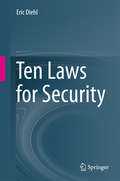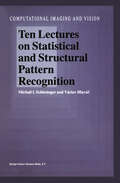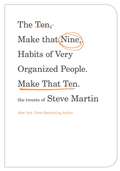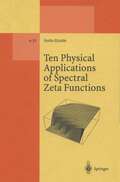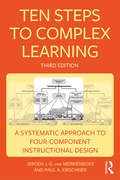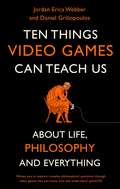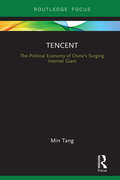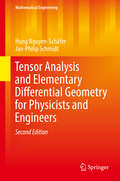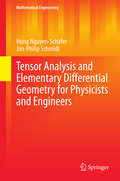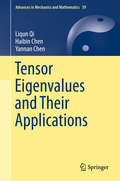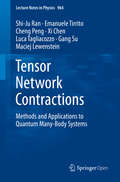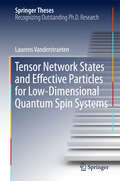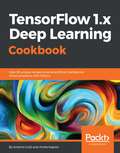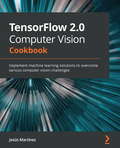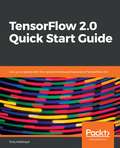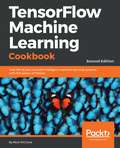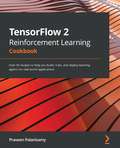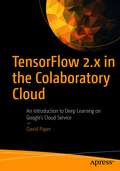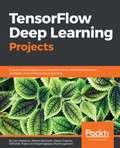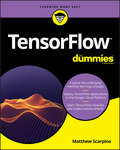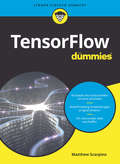- Table View
- List View
Ten Arguments For Deleting Your Social Media Accounts Right Now
by Jaron Lanier'A blisteringly good, urgent, essential read' ZADIE SMITHJaron Lanier, the world-famous Silicon Valley scientist-pioneer and 'high-tech genius' (Sunday Times) who first alerted us to the dangers of social media, explains why its toxic effects are at the heart of its design, and explains in ten simple arguments why liberating yourself from its hold will transform your life and the world for the better.Social media is making us sadder, angrier, less empathetic, more fearful, more isolated and more tribal. In recent months it has become horribly clear that social media is not bringing us together – it is tearing us apart. In Ten Arguments For Deleting Your Social Media Accounts Right Now Jaron Lanier draws on his insider's expertise to explain precisely how social media works – by deploying constant surveillance and subconscious manipulation of its users – and why its cruel and dangerous effects are at the heart of its current business model and design. As well as offering ten simple arguments for liberating yourself from its addictive hold, his witty and urgent manifesto outlines a vision for an alternative that provides all the benefits of social media without the harm. So, if you want a happier life, a more just and peaceful world, or merely the chance to think for yourself without being monitored and influenced by the richest corporations in history, then the best thing you can do, for now, is delete your social media accounts – right now. You will almost certainly become a calmer and possibly a nicer person in the process.
Ten Laws for Security
by Eric DiehlIn this book the author presents ten key laws governing information security. He addresses topics such as attacks, vulnerabilities, threats, designing security, identifying key IP assets, authentication, and social engineering. The informal style draws on his experience in the area of video protection and DRM, while the text is supplemented with introductions to the core formal technical ideas. It will be of interest to professionals and researchers engaged with information security.
Ten Lectures on Statistical and Structural Pattern Recognition (Computational Imaging and Vision #24)
by M.I. Schlesinger Václav HlavácPreface to the English edition This monograph Ten Lectur,es on Statistical and Structural Pattern Recognition uncovers the close relationship between various well known pattern recognition problems that have so far been considered independent. These relationships became apparent when formal procedures addressing not only known prob lems but also their generalisations were discovered. The generalised problem formulations were analysed mathematically and unified algorithms were found. The book unifies of two main streams ill pattern recognition-the statisti cal a11d structural ones. In addition to this bridging on the uppermost level, the book mentions several other unexpected relations within statistical and structural methods. The monograph is intended for experts, for students, as well as for those who want to enter the field of pattern recognition. The theory is built up from scratch with almost no assumptions about any prior knowledge of the reader. Even when rigorous mathematical language is used we make an effort to keep the text easy to comprehend. This approach makes the book suitable for students at the beginning of their scientific career. Basic building blocks are explained in a style of an accessible intellectual exercise, thus promoting good practice in reading mathematical text. The paradoxes, beauty, and pitfalls of scientific research are shown on examples from pattern recognition. Each lecture is amended by a discussion with an inquisitive student that elucidates and deepens the explanation, providing additional pointers to computational procedures and deep rooted errors.
The Ten, Make That Nine, Habits of Very Organized People. Make That Ten.: The Tweets of Steve Martin
by Steve MartinThe funniest, most memorable Twitter messages from comedian and bestselling author Steve Martin, along with hilarious responses from followers.Steve Martin's uncanny ability to pack 140 characters with humor and wit has defined what it means to be a celebrity in today's world of social media. With over 8 million followers on Twitter (a number growing by the day), Martin's tweets have been covered by personal blogs, major news outlets, and everything in between.Funny illustrations complement Martin's insights on everything from celebrity culture to jury duty to Twitter itself. Perfect, light reading for your hectic commute, busy waiting rooms, or a lazy Sunday afternoon, this collection will delight avid followers and offline fans alike.
Ten Physical Applications of Spectral Zeta Functions (Lecture Notes in Physics Monographs #35)
by Emilio ElizaldeThis monography is, in the first place, a commented guide that invites the reader to plunge into the thrilling world ofzeta functions and their appli cations in physics. Different aspects ofthis field ofknowledge are considered, as one can see specifically in the Table of Contents. The level of the book is elementary. It is intended for people with no or little knowledge of the subject. Everything is explained in full detail, in particular, the mathematical difficulties and tricky points, which too often constitute an insurmountable barrier for those who would have liked to be come aquainted with that matter but never dared to ask (or did not manage to understand more complete, higher-level treatises). In this sense the present work is to be considered as a basic introduction and exercise collection for other books that have appeared recently. Concerning the physical applications of the method ofzeta-function reg ularization here described, quite a big choice is presented. The reader must be warned, however, that I have not tried to explain the underlying physi cal theories in complete detail (since this is undoubtedly out of scope), but rather to illustrate - simply and clearly - the precise way the method must be applied. Sometimes zeta regularization is explicitly compared in the text with other procedures the reader is supposed to be more familiar with (such as cut-off or dimensional regularization).
Ten Steps to Complex Learning: A Systematic Approach to Four-Component Instructional Design
by Jeroen J. van Merriënboer Paul A. KirschnerTen Steps to Complex Learning presents a path from an educational problem to a solution in a way that students, practitioners, and researchers can understand and easily use. Students in the field of instructional design can use this book to broaden their knowledge of the design of training programs for complex learning. Practitioners can use this book as a reference guide to support their design of courses, curricula, or environments for complex learning. Now fully revised to incorporate the most current research in the field, this third edition of Ten Steps to Complex Learning includes many references to recent research as well as two new chapters. One new chapter deals with the training of 21st-century skills in educational programs based on the Ten Steps. The other deals with the design of assessment programs that are fully aligned with the Ten Steps. In the closing chapter, new directions for the further development of the Ten Steps are discussed.
Ten Things Video Games Can Teach Us: (about life, philosophy and everything)
by Jordan Erica Webber Daniel GriliopoulosWOULD YOU KILL ONE PERSON TO SAVE FIVE OTHERS?If you could upload all of your memories into a machine, would that machine be you? Is it possible we're all already artificial intelligences, living inside a simulation?These sound like questions from a philosophy class, but in fact they're from modern, popular video games. Philosophical discussion often uses thought experiments to consider ideas that we can't test in real life, and media like books, films, and games can make these thought experiments far more accessible to a non-academic audience. Thanks to their interactive nature, video games can be especially effective ways to explore these ideas.Each chapter of this book introduces a philosophical topic through discussion of relevant video games, with interviews with game creators and expert philosophers. In ten chapters, this book demonstrates how video games can help us to consider the following questions:1. Why do video games make for good thought experiments? (From the ethical dilemmas of the Mass Effect series to 'philosophy games'.)2. What can we actually know? (From why Phoenix Wright is right for the wrong reasons to whether No Man's Sky is a lie.)3. Is virtual reality a kind of reality? (On whether VR headsets like the Oculus Rift, PlayStation VR, and HTC Vive deal in mass-market hallucination.)4. What constitutes a mind? (From the souls of Beyond: Two Souls to the synths of Fallout 4.)5. What can you lose before you're no longer yourself? (Identity crises in the likes of The Swapper and BioShock Infinite.)6. Does it mean anything to say we have choice? (Determinism and free will in Bioshock, Portal 2 and Deus Ex.)7. What does it mean to be a good or dutiful person? (Virtue ethics in the Ultima series and duty ethics in Planescape: Torment.)8. Is there anything better in life than to be happy? (Utilitarianism in Bioshock 2 and Harvest Moon.)10. How should we be governed, for whom and by who? (Government and rights in Eve Online, Crusader Kings, Democracy 3 and Fable 3.)11. Is it ever right to take another life? And how do we cope with our own death? (The Harm Thesis and the good death in To The Moon and Lost Odyssey.)
Tencent: The Political Economy of China’s Surging Internet Giant (Global Media Giants)
by Min TangIn this book, author Min Tang examines the political economy of the China-based leading global Internet giant, Tencent. Tracing the historical context and shaping forces, the book illuminates Tencent’s emergence as a joint creation of the Chinese state and transnational financial capital. Tencent reveals interweaving axes of power on different levels, particularly interactions between the global digital industry and contemporary China. The expansion strategies Tencent has employed—horizontal and vertical integration, diversification and transnationalization—speak to the intrinsic trends of capitalist reproduction and the consistent features of the political economy of communications. The book also pinpoints two emerging and entangling trends— transnationalization and financialization—as unfolding trajectories of the global political economy. Understanding Tencent’s dynamics of growth helps to clarify the complex nature of China’s contemporary transformation and the multifaceted characteristics of its increasingly globalized Internet industry. This short and highly topical research volume is perfect for students and scholars of of global media, political economy, and Chinese business, media and communication, and society.
Tencent: The Political Economy of China’s Surging Internet Giant (Global Media Giants)
by Min TangIn this book, author Min Tang examines the political economy of the China-based leading global Internet giant, Tencent. Tracing the historical context and shaping forces, the book illuminates Tencent’s emergence as a joint creation of the Chinese state and transnational financial capital. Tencent reveals interweaving axes of power on different levels, particularly interactions between the global digital industry and contemporary China. The expansion strategies Tencent has employed—horizontal and vertical integration, diversification and transnationalization—speak to the intrinsic trends of capitalist reproduction and the consistent features of the political economy of communications. The book also pinpoints two emerging and entangling trends— transnationalization and financialization—as unfolding trajectories of the global political economy. Understanding Tencent’s dynamics of growth helps to clarify the complex nature of China’s contemporary transformation and the multifaceted characteristics of its increasingly globalized Internet industry. This short and highly topical research volume is perfect for students and scholars of of global media, political economy, and Chinese business, media and communication, and society.
Tensor Analysis and Elementary Differential Geometry for Physicists and Engineers (Mathematical Engineering #21)
by Hung Nguyen-Schäfer Jan-Philip SchmidtThis book presents tensors and differential geometry in a comprehensive and approachable manner, providing a bridge from the place where physics and engineering mathematics end, and the place where tensor analysis begins. Among the topics examined are tensor analysis, elementary differential geometry of moving surfaces, and k-differential forms. The book includes numerous examples with solutions and concrete calculations, which guide readers through these complex topics step by step. Mindful of the practical needs of engineers and physicists, book favors simplicity over a more rigorous, formal approach. The book shows readers how to work with tensors and differential geometry and how to apply them to modeling the physical and engineering world.The authors provide chapter-length treatment of topics at the intersection of advanced mathematics, and physics and engineering: • General Basis and Bra-Ket Notation• Tensor Analysis• Elementary Differential Geometry• Differential Forms• Applications of Tensors and Differential Geometry• Tensors and Bra-Ket Notation in Quantum MechanicsThe text reviews methods and applications in computational fluid dynamics; continuum mechanics; electrodynamics in special relativity; cosmology in the Minkowski four-dimensional space time; and relativistic and non-relativistic quantum mechanics.Tensor Analysis and Elementary Differential Geometry for Physicists and Engineers benefits research scientists and practicing engineers in a variety of fields, who use tensor analysis and differential geometry in the context of applied physics, and electrical and mechanical engineering. It will also interest graduate students in applied physics and engineering.
Tensor Analysis and Elementary Differential Geometry for Physicists and Engineers (Mathematical Engineering #21)
by Hung Nguyen-Schäfer Jan-Philip SchmidtTensors and methods of differential geometry are very useful mathematical tools in many fields of modern physics and computational engineering including relativity physics, electrodynamics, computational fluid dynamics (CFD), continuum mechanics, aero and vibroacoustics and cybernetics.This book comprehensively presents topics, such as bra-ket notation, tensor analysis and elementary differential geometry of a moving surface. Moreover, authors intentionally abstain from giving mathematically rigorous definitions and derivations that are however dealt with as precisely as possible. The reader is provided with hands-on calculations and worked-out examples at which he will learn how to handle the bra-ket notation, tensors and differential geometry and to use them in the physical and engineering world. The target audience primarily comprises graduate students in physics and engineering, research scientists and practicing engineers.
Tensor Eigenvalues and Their Applications (Advances in Mechanics and Mathematics #39)
by Liqun Qi Haibin Chen Yannan ChenThis book offers an introduction to applications prompted by tensor analysis, especially by the spectral tensor theory developed in recent years. It covers applications of tensor eigenvalues in multilinear systems, exponential data fitting, tensor complementarity problems, and tensor eigenvalue complementarity problems. It also addresses higher-order diffusion tensor imaging, third-order symmetric and traceless tensors in liquid crystals, piezoelectric tensors, strong ellipticity for elasticity tensors, and higher-order tensors in quantum physics. This book is a valuable reference resource for researchers and graduate students who are interested in applications of tensor eigenvalues.
Tensor Network Contractions: Methods and Applications to Quantum Many-Body Systems (Lecture Notes in Physics #964)
by Shi-Ju Ran Emanuele Tirrito Cheng Peng Xi Chen Luca Tagliacozzo Gang Su Maciej LewensteinTensor network is a fundamental mathematical tool with a huge range of applications in physics, such as condensed matter physics, statistic physics, high energy physics, and quantum information sciences. This open access book aims to explain the tensor network contraction approaches in a systematic way, from the basic definitions to the important applications. This book is also useful to those who apply tensor networks in areas beyond physics, such as machine learning and the big-data analysis. Tensor network originates from the numerical renormalization group approach proposed by K. G. Wilson in 1975. Through a rapid development in the last two decades, tensor network has become a powerful numerical tool that can efficiently simulate a wide range of scientific problems, with particular success in quantum many-body physics. Varieties of tensor network algorithms have been proposed for different problems. However, the connections among different algorithms are not well discussed or reviewed. To fill this gap, this book explains the fundamental concepts and basic ideas that connect and/or unify different strategies of the tensor network contraction algorithms. In addition, some of the recent progresses in dealing with tensor decomposition techniques and quantum simulations are also represented in this book to help the readers to better understand tensor network. This open access book is intended for graduated students, but can also be used as a professional book for researchers in the related fields. To understand most of the contents in the book, only basic knowledge of quantum mechanics and linear algebra is required. In order to fully understand some advanced parts, the reader will need to be familiar with notion of condensed matter physics and quantum information, that however are not necessary to understand the main parts of the book. This book is a good source for non-specialists on quantum physics to understand tensor network algorithms and the related mathematics.
Tensor Network States and Effective Particles for Low-Dimensional Quantum Spin Systems (Springer Theses)
by Laurens VanderstraetenThis thesis develops new techniques for simulating the low-energy behaviour of quantum spin systems in one and two dimensions. Combining these developments, it subsequently uses the formalism of tensor network states to derive an effective particle description for one- and two-dimensional spin systems that exhibit strong quantum correlations. These techniques arise from the combination of two themes in many-particle physics: (i) the concept of quasiparticles as the effective low-energy degrees of freedom in a condensed-matter system, and (ii) entanglement as the characteristic feature for describing quantum phases of matter. Whereas the former gave rise to the use of effective field theories for understanding many-particle systems, the latter led to the development of tensor network states as a description of the entanglement distribution in quantum low-energy states.
TensorFlow 1.x Deep Learning Cookbook
by Antonio GulliIn this book, you will learn how to efficiently use TensorFlow, Google's open source framework for deep learning. You will implement different deep learning networks such as Convolutional Neural Networks (CNNs), Recurrent Neural Networks (RNNs), Deep Q-learning Networks (DQNs), and Generative Adversarial Networks (GANs) with easy to follow independent recipes.
TensorFlow 2.0 Computer Vision Cookbook: Implement machine learning solutions to overcome various computer vision challenges
by Jesus MartinezGet well versed with state-of-the-art techniques to tailor training processes and boost the performance of computer vision models using machine learning and deep learning techniquesKey FeaturesDevelop, train, and use deep learning algorithms for computer vision tasks using TensorFlow 2.xDiscover practical recipes to overcome various challenges faced while building computer vision modelsEnable machines to gain a human level understanding to recognize and analyze digital images and videosBook DescriptionComputer vision is a scientific field that enables machines to identify and process digital images and videos. This book focuses on independent recipes to help you perform various computer vision tasks using TensorFlow. The book begins by taking you through the basics of deep learning for computer vision, along with covering TensorFlow 2.x's key features, such as the Keras and tf.data.Dataset APIs. You'll then learn about the ins and outs of common computer vision tasks, such as image classification, transfer learning, image enhancing and styling, and object detection. The book also covers autoencoders in domains such as inverse image search indexes and image denoising, while offering insights into various architectures used in the recipes, such as convolutional neural networks (CNNs), region-based CNNs (R-CNNs), VGGNet, and You Only Look Once (YOLO). Moving on, you'll discover tips and tricks to solve any problems faced while building various computer vision applications. Finally, you'll delve into more advanced topics such as Generative Adversarial Networks (GANs), video processing, and AutoML, concluding with a section focused on techniques to help you boost the performance of your networks. By the end of this TensorFlow book, you'll be able to confidently tackle a wide range of computer vision problems using TensorFlow 2.x.What you will learnUnderstand how to detect objects using state-of-the-art models such as YOLOv3Use AutoML to predict gender and age from imagesSegment images using different approaches such as FCNs and generative modelsLearn how to improve your network's performance using rank-N accuracy, label smoothing, and test time augmentationEnable machines to recognize people's emotions in videos and real-time streamsAccess and reuse advanced TensorFlow Hub models to perform image classification and object detectionGenerate captions for images using CNNs and RNNsWho this book is forThis book is for computer vision developers and engineers, as well as deep learning practitioners looking for go-to solutions to various problems that commonly arise in computer vision. You will discover how to employ modern machine learning (ML) techniques and deep learning architectures to perform a plethora of computer vision tasks. Basic knowledge of Python programming and computer vision is required.
TensorFlow 2.0 Quick Start Guide: Get Up To Speed With The Newly Introduced Features Of Tensorflow 2. 0
by Tony HoldroydTensorFlow is one of the most popular machine learning frameworks in Python. With this book, you will improve your knowledge of some of the latest TensorFlow features and will be able to perform supervised and unsupervised machine learning and also train neural networks.
TensorFlow 2 Machine Learning Cookbook: Over 60 Recipes To Build Intelligent Machine Learning Systems With The Power Of Python, 2nd Edition
by Nick McClureThis book will help you overcome any problem you might come across while training and deploying machine learning models using the recently released Tensorflow. This book includes recipes on important machine learning concepts such as supervised and unsupervised learning, as well as neural networks and their real-world applications.
TensorFlow 2 Reinforcement Learning Cookbook: Over 50 recipes to help you build, train, and deploy learning agents for real-world applications
by Praveen PalanisamyDiscover recipes for developing AI applications to solve a variety of real-world business problems using reinforcement learningKey FeaturesDevelop and deploy deep reinforcement learning-based solutions to production pipelines, products, and servicesExplore popular reinforcement learning algorithms such as Q-learning, SARSA, and the actor-critic methodCustomize and build RL-based applications for performing real-world tasksBook DescriptionWith deep reinforcement learning, you can build intelligent agents, products, and services that can go beyond computer vision or perception to perform actions. TensorFlow 2.x is the latest major release of the most popular deep learning framework used to develop and train deep neural networks (DNNs). This book contains easy-to-follow recipes for leveraging TensorFlow 2.x to develop artificial intelligence applications. Starting with an introduction to the fundamentals of deep reinforcement learning and TensorFlow 2.x, the book covers OpenAI Gym, model-based RL, model-free RL, and how to develop basic agents. You'll discover how to implement advanced deep reinforcement learning algorithms such as actor-critic, deep deterministic policy gradients, deep-Q networks, proximal policy optimization, and deep recurrent Q-networks for training your RL agents. As you advance, you'll explore the applications of reinforcement learning by building cryptocurrency trading agents, stock/share trading agents, and intelligent agents for automating task completion. Finally, you'll find out how to deploy deep reinforcement learning agents to the cloud and build cross-platform apps using TensorFlow 2.x. By the end of this TensorFlow book, you'll have gained a solid understanding of deep reinforcement learning algorithms and their implementations from scratch.What you will learnBuild deep reinforcement learning agents from scratch using the all-new TensorFlow 2.x and Keras APIImplement state-of-the-art deep reinforcement learning algorithms using minimal codeBuild, train, and package deep RL agents for cryptocurrency and stock tradingDeploy RL agents to the cloud and edge to test them by creating desktop, web, and mobile apps and cloud servicesSpeed up agent development using distributed DNN model trainingExplore distributed deep RL architectures and discover opportunities in AIaaS (AI as a Service)Who this book is forThe book is for machine learning application developers, AI and applied AI researchers, data scientists, deep learning practitioners, and students with a basic understanding of reinforcement learning concepts who want to build, train, and deploy their own reinforcement learning systems from scratch using TensorFlow 2.x.
TensorFlow 2.x in the Colaboratory Cloud: An Introduction to Deep Learning on Google’s Cloud Service
by David PaperUse TensorFlow 2.x with Google's Colaboratory (Colab) product that offers a free cloud service for Python programmers. Colab is especially well suited as a platform for TensorFlow 2.x deep learning applications. You will learn Colab’s default install of the most current TensorFlow 2.x along with Colab’s easy access to on-demand GPU hardware acceleration in the cloud for fast execution of deep learning models. This book offers you the opportunity to grasp deep learning in an applied manner with the only requirement being an Internet connection. Everything else—Python, TensorFlow 2.x, GPU support, and Jupyter Notebooks—is provided and ready to go from Colab. The book begins with an introduction to TensorFlow 2.x and the Google Colab cloud service. You will learn how to provision a workspace on Google Colab and build a simple neural network application. From there you will progress into TensorFlow datasets and building input pipelines in support of modeling and testing. You will find coverage of deep learning classification and regression, with clear code examples showing how to perform each of those functions. Advanced topics covered in the book include convolutional neural networks and recurrent neural networks. This book contains all the applied math and programming you need to master the content. Examples range from simple to relatively complex when necessary to ensure acquisition of appropriate deep learning concepts and constructs. Examples are carefully explained, concise, accurate, and complete to perfectly complement deep learning skill development. Care is taken to walk you through the foundational principles of deep learning through clear examples written in Python that you can try out and experiment with using Google Colab from the comfort of your own home or office.What You Will LearnBe familiar with the basic concepts and constructs of applied deep learningCreate machine learning models with clean and reliable Python codeWork with datasets common to deep learning applicationsPrepare data for TensorFlow consumptionTake advantage of Google Colab’s built-in support for deep learningExecute deep learning experiments using a variety of neural network modelsBe able to mount Google Colab directly to your Google Drive accountVisualize training versus test performance to see model fitWho This Book Is ForReaders who want to learn the highly popular TensorFlow 2.x deep learning platform, those who wish to master deep learning fundamentals that are sometimes skipped over in the rush to be productive, and those looking to build competency with a modern cloud service tool such as Google Colab
TensorFlow Deep Learning Projects: 10 Real-world Projects On Computer Vision, Machine Translation, Chatbots, And Reinforcement Learning
by Luca MassaronThis book is your guide to master deep learning with TensorFlow, with the help of 10 real-world projects. You will train high-performance models in TensorFlow to generate captions for images automatically, predict stocks' performance, create intelligent chatbots, perform large-scale text classification, develop recommendation systems, and more.
TensorFlow Developer Certificate Guide: Efficiently tackle deep learning and ML problems to ace the Developer Certificate exam
by Oluwole FagbohunAchieve TensorFlow certification with this comprehensive guide covering all exam topics using a hands-on, step-by-step approach—perfect for aspiring TensorFlow developersKey FeaturesBuild real-world computer vision, natural language, and time series applicationsLearn how to overcome issues such as overfitting with techniques such as data augmentationMaster transfer learning—what it is and how to build applications with pre-trained modelsPurchase of the print or Kindle book includes a free PDF eBookBook DescriptionThe TensorFlow Developer Certificate Guide is an indispensable resource for machine learning enthusiasts and data professionals seeking to master TensorFlow and validate their skills by earning the certification. This practical guide equips you with the skills and knowledge necessary to build robust deep learning models that effectively tackle real-world challenges across diverse industries. You’ll embark on a journey of skill acquisition through easy-to-follow, step-by-step explanations and practical examples, mastering the craft of building sophisticated models using TensorFlow 2.x and overcoming common hurdles such as overfitting and data augmentation. With this book, you’ll discover a wide range of practical applications, including computer vision, natural language processing, and time series prediction. To prepare you for the TensorFlow Developer Certificate exam, it offers comprehensive coverage of exam topics, including image classification, natural language processing (NLP), and time series analysis. With the TensorFlow certification, you’ll be primed to tackle a broad spectrum of business problems and advance your career in the exciting field of machine learning. Whether you are a novice or an experienced developer, this guide will propel you to achieve your aspirations and become a highly skilled TensorFlow professional. What you will learnPrepare for success in the TensorFlow Developer Certification examMaster regression and classification modelling with TensorFlow 2.xBuild, train, evaluate, and fine-tune deep learning modelsCombat overfitting using techniques such as dropout and data augmentationClassify images, encompassing preprocessing and image data augmentationApply TensorFlow for NLP tasks like text classification and generationPredict time series data, such as stock pricesExplore real-world case studies and engage in hands-on exercisesWho this book is forThis book is for machine learning and data science enthusiasts, as well as data professionals aiming to demonstrate their expertise in building deep learning applications with TensorFlow. Through a comprehensive hands-on approach, this book covers all the essential exam prerequisites to equip you with the skills needed to excel as a TensorFlow developer and advance your career in machine learning. A fundamental grasp of Python programming is the only prerequisite.
TensorFlow For Dummies
by Matthew ScarpinoBecome a machine learning pro! Google TensorFlow has become the darling of financial firms and research organizations, but the technology can be intimidating and the learning curve is steep. Luckily, TensorFlow For Dummies is here to offer you a friendly, easy-to-follow book on the subject. Inside, you’ll find out how to write applications with TensorFlow, while also grasping the concepts underlying machine learning—all without ever losing your cool! Machine learning has become ubiquitous in modern society, and its applications include language translation, robotics, handwriting analysis, financial prediction, and image recognition. TensorFlow is Google's preeminent toolset for machine learning, and this hands-on guide makes it easy to understand, even for those without a background in artificial intelligence. Install TensorFlow on your computer Learn the fundamentals of statistical regression and neural networks Visualize the machine learning process with TensorBoard Perform image recognition with convolutional neural networks (CNNs) Analyze sequential data with recurrent neural networks (RNNs) Execute TensorFlow on mobile devices and the Google Cloud Platform (GCP) If you’re a manager or software developer looking to use TensorFlow for machine learning, this is the book you’ll want to have close by.
TensorFlow For Dummies
by Matthew ScarpinoBecome a machine learning pro! Google TensorFlow has become the darling of financial firms and research organizations, but the technology can be intimidating and the learning curve is steep. Luckily, TensorFlow For Dummies is here to offer you a friendly, easy-to-follow book on the subject. Inside, you’ll find out how to write applications with TensorFlow, while also grasping the concepts underlying machine learning—all without ever losing your cool! Machine learning has become ubiquitous in modern society, and its applications include language translation, robotics, handwriting analysis, financial prediction, and image recognition. TensorFlow is Google's preeminent toolset for machine learning, and this hands-on guide makes it easy to understand, even for those without a background in artificial intelligence. Install TensorFlow on your computer Learn the fundamentals of statistical regression and neural networks Visualize the machine learning process with TensorBoard Perform image recognition with convolutional neural networks (CNNs) Analyze sequential data with recurrent neural networks (RNNs) Execute TensorFlow on mobile devices and the Google Cloud Platform (GCP) If you’re a manager or software developer looking to use TensorFlow for machine learning, this is the book you’ll want to have close by.
TensorFlow für Dummies (Für Dummies)
by Matthew ScarpinoTensorFlow ist Googles herausragendes Werkzeug für das maschinelle Lernen, und dieses Buch macht es zugänglich, selbst wenn Sie bisher wenig über neuronale Netze und Deep Learning wissen. Sie erfahren, auf welchen Prinzipien TensorFlow basiert und wie Sie mit TensorFlow Anwendungen 1.0 schreiben. Gleichzeitig lernen Sie die Konzepte des maschinellen Lernens kennen. Wenn Sie Softwareentwickler sind und TensorFlow in Zukunft einsetzen möchten, dann ist dieses Buch der richtige Einstieg für Sie. Greifen Sie auch zu, wenn Sie einfach mehr über das maschinelle Lernen erfahren wollen.

